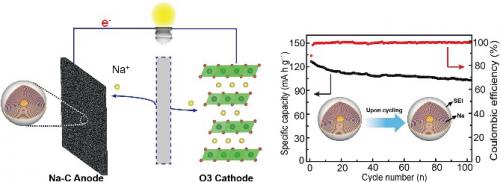
On March 29th, Functional Materials and Biomass Utilization research group from College of Sciences of HZAU made significant improvement in energy storage research. The research result was published online in the internationally renowned academic journal Nano Energy entitled “Realizing a Highly Stable Sodium Battery with Dendrite-Free Sodium Metal Composite Anodes and O3-Type Cathodes”. Associate Professor Ye Huan, from the College of Sciences, HZAU, was the first author, Associate Professor Cao Feifei of HZAU and Prof. Guo Yuguo from Institute of Chemistry, Chinese Academy of Sciences are coauthors.
Room-temperature Na metal rechargeable battery have been regarded as promising candidates for high energy density rechargeable battery due to the high theoretical specific capacity, low reduction potential and low cost of Na. However, the practical application of metallic Na anode is impeded by its low plating-stripping Coulombic efficiency and poor cycling performance caused by the formation of inhomogeneous solid electrolyte interphase(SEI) and dendritic Na, and large volumetric expansion of Na upon cycling. This research group for the first time put forward the concept of three dimensional Na-C Composite anode, which can realize a homogeneous Na nucleation, a high reversibility of Na, and a negligible variation of volume.
The Na-C composite anode was fabricated by depositing nanoscale metallic Na in onion-like, graphitized carbon microspheres hosts which were assembled from graphitized carbon nanosheets. On the one hand, embedding nanoscale metallic Na inside the graphitized carbon nanosheets would ensure the high electrochemical activity of Na, while further ensure high reversibility of Na. On the other hand, the graphitized carbon nanosheets regarding as an artificial SEI layer could effectively prevent metallic Na reacting with the electrolyte, and alleviate large volume expansion, affording high Coulombic efficiency. As a result, the constructed 3D Na-C composite anode exhibits superior suppression in dendrites, a negligible volume change, and demonstrates a high reversibility (a high Coulombic efficiency of 99.3% at 4 mA/cm2 ), and ultralong lifespan (cycling over 3500 h at 0.5 mA/cm2). In addition, a secondary Na metal full battery based on this 3D Na-C anode coupled with O3-NaNi0.5Mn0.2Ti0.3O2 cathode was constructed to showcase its practicality by achieving a superior long lifespan of ~100 cycles at high current density of 0.5 C.
The research presented herein analyzed the relationship between the existence forms and electrochemical performances of metallic Na, and proposed the concept of Na-C composite anode on the basis of carbon materials, which is a significant breakthrough in metallic Na anode. The research is strongly supported by the National Natural Science Foundation, the National Key R & D Program of China and Fundamental Research Funds for the Central Universities of China.
